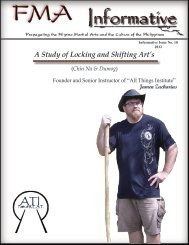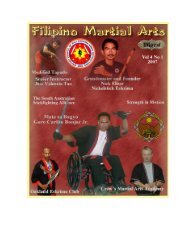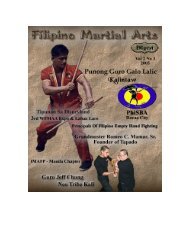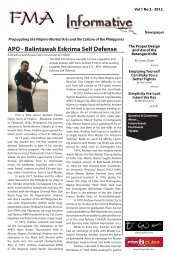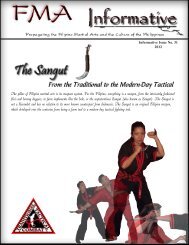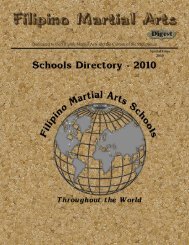Tournaments - FMA Informative
Tournaments - FMA Informative
Tournaments - FMA Informative
You also want an ePaper? Increase the reach of your titles
YUMPU automatically turns print PDFs into web optimized ePapers that Google loves.
DS: My primary Silat training is under Maha Guru Cliff Stewart, founder of Kilat<br />
Pukulan Pencak Silat and Guru Thomas Lomax, Guru Stewart’s most senior student. I<br />
have also had the opportunity to learn aspects<br />
of Silat from Pendekar Richard DeBordes<br />
of Harimau Minangkabau and Pendekar Steven<br />
Benitez, Wali Songo Pencak Silat.<br />
<strong>FMA</strong>digest: How are African Warrior<br />
Arts combined into your system?<br />
DS: Once a student attains the level of<br />
Guro, they are then introduced to various<br />
aspects of African Warrior Combatives.<br />
Some of them include wrestling (Gdigbo/<br />
Eke), spear and shield from the Zulu’s,<br />
the<br />
Naboot Stick (4’ Staff), Wrist and Ankle<br />
Knives, and much more. My primary<br />
teacher in these combatives is Ahati<br />
Kilindi Iyi. I am also in the process of<br />
learning the Ga-Damgbe Warrior<br />
Arts and will be traveling to Ghana, West Afrika in<br />
August<br />
2007 to learn the Wrestling, Knife Tactics, Boxing, the Dances, and the spiritual<br />
aspects of the Ga community.<br />
<strong>FMA</strong>digest: Please explain the components of Sadiq Kali Silat?<br />
DS: Sadiq Kali Silat begins training in the empty hand, palm stick, single stick and basic<br />
edged weapon tactics. Our beginning-training module begins with a heavy emphasis on<br />
footwork and how to use the footwork both offensively and defensively. Students cover<br />
basic strikes and blocks with both weapons and empty hands. Our empty hand component<br />
also covers multiple striking, low line kicks, joint locks, arm-bars, throws, and practical<br />
self-defense tactics. The primary emphasis in the beginning weapon component is the<br />
learning of basic passing along with blocking and countering. Our edged weapon tactics<br />
include learning the basic strikes and targets, along with emphasizing re-directing,<br />
parrying, and passing the blade with the proper body movement and angles. Non-contact<br />
sparring with the stick is an essential aspect of the beginner syllabus.<br />
In more advanced aspects of Sadiq, emphasis is placed on weapon-boxing and<br />
stick-grappling implementing both the weapon<br />
and live hand. There is always an<br />
importa nce placed on incorporating both upper and lower body in all aspects offensively<br />
and defensively with the knife and sticks.<br />
Once a student is promoted to Trainer (Tagapagsanay), they now emphasize the<br />
combatives stage. The combative stage emphasizes fighting, and the incorporation of all<br />
of the previous learned components. Contact levels range from light<br />
contact to hard<br />
contact.<br />
Students are also taught the various sub-styles of the system including: Ocho –<br />
Ocho, Abaniko, Redondo, Sungkiti, and Sinawali, among others.<br />
<strong>FMA</strong>digest: Can you discuss a little about Kamau Ryu, and tell us the basic concept?<br />
DS: Grandmaster Ron Van Clief officially sanctioned Kamau Ryu in 1993. Kamau Ryu<br />
primarily emphasizes the Ju Jitsu and Aiki Jitsu teachings of legendary Grandmasters<br />
Prof. Florendo Visitacion (Vee Jitsu Ryu Ju Jitsu), Dr. Moses Powell (Sanuces Ryu),



